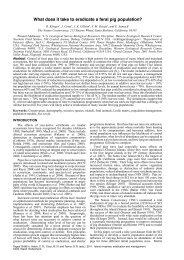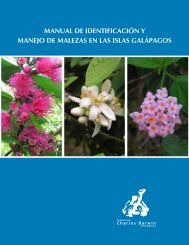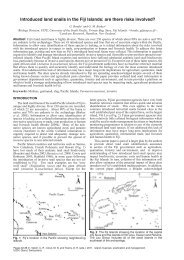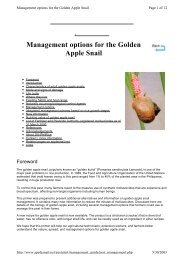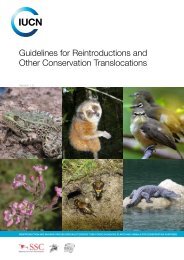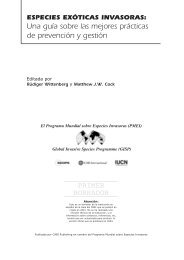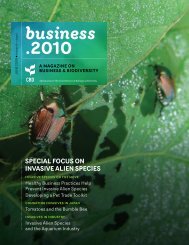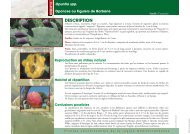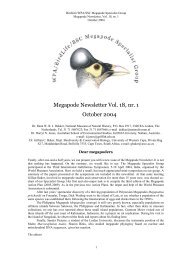Aliens - ISSG
Aliens - ISSG
Aliens - ISSG
You also want an ePaper? Increase the reach of your titles
YUMPU automatically turns print PDFs into web optimized ePapers that Google loves.
Aerial broadcast of rodenticide on the island of Sa Dragonera<br />
(Balearic Islands, Spain). A promising rodent eradication experience<br />
on a Mediterranean island<br />
Joan Mayol, Martí Mayol, Oriol Domenech, Joan Oliver, Miguel McMinn, Ana Rodríguez<br />
The Natural Park of Sa Dragonera is a small group<br />
of non-habited islands just off the coast of the summer<br />
holiday destination island of Mallorca. Sa Dragonera,<br />
which gives its name to the Natural Park, is<br />
a massive limestone island of 362 ha that protrudes<br />
out of the sea as the northwestern extension of the<br />
Tramuntana mountain range of Mallorca. The island<br />
is over 4 km long with a maximum peak altitude of<br />
360 m. The north coast of sa Dragonera is dominated<br />
by abrupt cliffs that plunge vertically in the<br />
turquoise blue Mediterranean. Along the southern<br />
coast, much less abrupt, the visitor can find beautifully<br />
preserved natural coves and the only harbor<br />
and landing place to access the Park. Outstanding<br />
natural values of Sa Dragonera are the important<br />
breeding colonies of six Mediterranean seabirds:<br />
shag, yellow-legged gull, Audouin’s gull, Scopoli’s<br />
shearwater, European storm petrel and Balearic<br />
shearwater (a critically endangered shearwater that<br />
only breeds in the Balearic Islands).<br />
The island is also an important breeding site in the<br />
Mediterranean for the rare Eleonora’s falcon. Other<br />
important bird species that breed on the island are<br />
the Peregrine falcon and the Balearic warbler. The<br />
osprey doesn’t breed on sa Dragonera, but they do<br />
regularly fish in the sea strait that separates the island<br />
from Mallorca. The non-avian fauna is no less<br />
important, among which is the Balearic wall lizard,<br />
a survivor of the pre-human fauna of the Balearic<br />
islands, and 25 endemic invertebrates (mostly land<br />
snails and beetles). The flora of sa Dragonera includes<br />
372 species, of which 12 are endemic to the<br />
Balearic islands.<br />
In the 1970’s a devastating development plan was<br />
Fig. 1 - The complet team involved in the project: the flags were used as signal to the helicopter for precise flyways<br />
(See also map in fig. 3). Photo: Martí Mayol.<br />
<strong>Aliens</strong> 29



